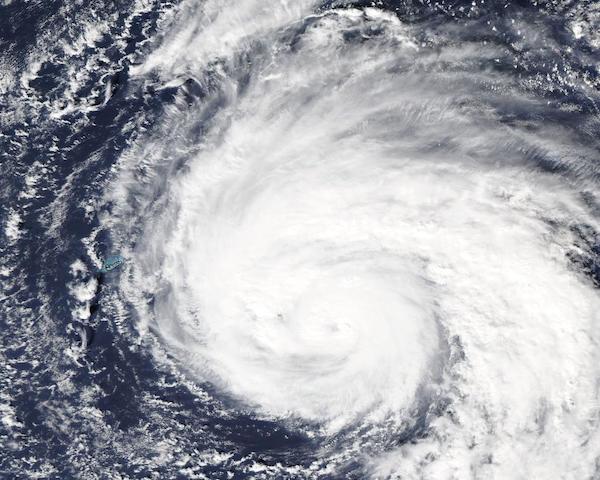Images
October 24, 2020 - Hurricane Epsilon
Tweet
Hurricane Epsilon was spinning in the Atlantic Ocean east of Bermuda on October 22, 2020 when the Moderate Resolution Imaging Spectroradiometer (MODIS) on board NASA’s Aqua satellite acquired a true-color image of the storm. A bit of Bermuda green can be seen peeking out of the western edge of the storm as Epsilon brought wind and rain to the island nation.
According to the National Hurricane Center (NHC), at 0600 UTC (2:00 a.m. EDT) on October 22 Hurricane Epsilon was roaring at peak strength, packing maximum sustained winds of 115 mph (185 km/h), making it a Category 3 storm on the Saffir Simpson Hurricane Wind Scale. At that time, it was located 285 mi (460 km) east southeast of Bermuda. Epsilon had just completed a remarkable rapid intensification, jumping from a tropical storm with wind speeds of 45 mph (72.4 km/h) on the morning of October 20 to a Category 3 major hurricane with 115 mph (185 km/h) maximum sustained winds on the afternoon on October 21—a leap of 70 mph (112.6 km/h) in little over 24 hours.
Fortunately, Hurricane Epsilon began to fight wind shear in the pre-dawn hours of October 22, forcing substantial weakening before it passed east of Bermuda. By 2100 UTC (5:00 p.m. EDT) Hurricane Epsilon was located approximately 200 miles (325 km) east of Bermuda and maximum sustained winds had dropped to 85 mph (140 km/h). The sharp weakening and the eastern track helped spare Bermuda from suffering substantial damage.
As of 2100 UTC (5:00 p.m. EDT) on October 23, Hurricane Epsilon was located about 285 miles (455 km) northeast of Bermuda and was tracking north at 12 mph (19 km/h). It was still carrying winds of 85 mph (140 km/h) and is expected to remain at or near that strength as it travels over open water until gradual weakening begins in about 48 hours. It may lose tropical characteristics at about that time. Remnants of Epsilon are expected to reach the United Kingdom by early next week.
Image Facts
Satellite:
Aqua
Date Acquired: 10/22/2020
Resolutions:
1km (171.1 KB), 500m (550.7 KB), 250m (1.6 MB)
Bands Used: 1,4,3
Image Credit:
MODIS Land Rapid Response Team, NASA GSFC
Tweet
Hurricane Epsilon was spinning in the Atlantic Ocean east of Bermuda on October 22, 2020 when the Moderate Resolution Imaging Spectroradiometer (MODIS) on board NASA’s Aqua satellite acquired a true-color image of the storm. A bit of Bermuda green can be seen peeking out of the western edge of the storm as Epsilon brought wind and rain to the island nation.
According to the National Hurricane Center (NHC), at 0600 UTC (2:00 a.m. EDT) on October 22 Hurricane Epsilon was roaring at peak strength, packing maximum sustained winds of 115 mph (185 km/h), making it a Category 3 storm on the Saffir Simpson Hurricane Wind Scale. At that time, it was located 285 mi (460 km) east southeast of Bermuda. Epsilon had just completed a remarkable rapid intensification, jumping from a tropical storm with wind speeds of 45 mph (72.4 km/h) on the morning of October 20 to a Category 3 major hurricane with 115 mph (185 km/h) maximum sustained winds on the afternoon on October 21—a leap of 70 mph (112.6 km/h) in little over 24 hours.
Fortunately, Hurricane Epsilon began to fight wind shear in the pre-dawn hours of October 22, forcing substantial weakening before it passed east of Bermuda. By 2100 UTC (5:00 p.m. EDT) Hurricane Epsilon was located approximately 200 miles (325 km) east of Bermuda and maximum sustained winds had dropped to 85 mph (140 km/h). The sharp weakening and the eastern track helped spare Bermuda from suffering substantial damage.
As of 2100 UTC (5:00 p.m. EDT) on October 23, Hurricane Epsilon was located about 285 miles (455 km) northeast of Bermuda and was tracking north at 12 mph (19 km/h). It was still carrying winds of 85 mph (140 km/h) and is expected to remain at or near that strength as it travels over open water until gradual weakening begins in about 48 hours. It may lose tropical characteristics at about that time. Remnants of Epsilon are expected to reach the United Kingdom by early next week.
Image Facts
Satellite:
Aqua
Date Acquired: 10/22/2020
Resolutions:
1km (171.1 KB), 500m (550.7 KB), 250m (1.6 MB)
Bands Used: 1,4,3
Image Credit:
MODIS Land Rapid Response Team, NASA GSFC




